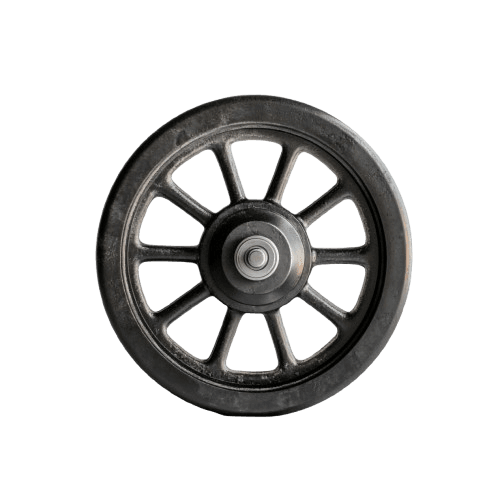In industrial settings, where heavy machinery, equipment, and materials are frequently moved, ensuring safety, efficiency, and stability is of paramount importance. One essential yet often overlooked component in industrial environments is the locking caster wheels. These wheels play a significant role in maintaining control over equipment, ensuring stability during use, and promoting a safer workspace. Their versatility, combined with their functionality, makes them a crucial part of any industrial or commercial operation.
Understanding Locking Caster Wheels
A locking caster wheel is a type of caster equipped with a mechanism that enables it to be fixed in place when necessary. This locking feature ensures that the equipment or machinery on which the casters are installed remains stationary, preventing unwanted movement. Locking casters are commonly found on carts, trolleys, racks, and other industrial equipment, where stability and safety are required during both operation and downtime.
These caster wheels are usually designed with a dual mechanism: one to lock the wheel from rotating and another to prevent it from swiveling. When both functions are engaged, they ensure the equipment remains firmly in place. The locking mechanism is typically activated by either a foot pedal or a manual lever, offering ease of use for operators.
Why Locking Caster Wheels Are Crucial for Stability
One of the primary benefits of locking caster wheels is their ability to provide stability. In an industrial environment, heavy loads are often moved across various surfaces, from smooth floors to rough, uneven terrain. Without the ability to lock the wheels in place, equipment can shift unexpectedly, causing instability and potential safety hazards.
For example, during the loading or unloading of materials, a cart or piece of machinery with non-locking casters may roll away or tip over, creating dangerous situations. Locking caster wheels allow operators to secure the equipment in place while performing tasks like loading or conducting maintenance, reducing the risk of accidents or injuries.
When working with equipment that needs to stay stationary during use, such as machines in factories or medical equipment in hospitals, locking casters are essential. In these cases, stability is not just about preventing the equipment from rolling away; it’s also about ensuring that it doesn’t move while in use, which could lead to damage, misalignment, or operational inefficiency.
Enhancing Safety with Locking Caster Wheels
Safety in industrial settings is a primary concern. Accidents caused by unexpected movements of equipment or machinery can lead to injuries, damage to property, and costly downtime. Locking caster wheels significantly reduce the chances of such incidents by providing a secure and stable foundation for equipment during operation.
For instance, in environments like warehouses or hospitals, where carts and medical equipment are frequently moved, the ability to lock the wheels in place ensures that the equipment remains stationary when not in use. This can be especially critical in areas where precision and careful handling are required. In a hospital setting, locking caster wheels on medical carts or patient beds can prevent them from rolling away during treatment or procedures, ensuring patient safety.
In addition to preventing rolling, locking caster wheels also prevent unintended swiveling. Swiveling casters allow for 360-degree movement, which is beneficial for maneuverability. However, when combined with a locking mechanism, the swiveling motion can be halted, providing better control in tight spaces or when maneuvering heavy loads. This feature enhances operator safety by reducing the chances of the equipment veering off course or causing accidents.
Durability and Long-Term Benefits of Locking Caster Wheels
Locking caster wheels not only contribute to safety and stability but also provide long-term benefits in terms of durability and cost-effectiveness. Many industrial applications involve the constant movement of equipment across floors with high traffic. This continuous motion can cause wear and tear on both the equipment and the flooring if the wheels are not designed to handle the stress.
Locking caster wheels are typically built with strong, durable materials that can withstand the rigors of heavy-duty use. Whether it’s in manufacturing plants, warehouses, or logistics facilities, the locking mechanism helps reduce the amount of friction and strain on the wheel, ensuring its longevity. In turn, this leads to less frequent replacement and lower maintenance costs, providing a more cost-effective solution over time.
Conclusion
In industrial and commercial settings, the role of locking caster wheels extends far beyond simple mobility. They are vital for ensuring the stability, safety, and efficiency of equipment and machinery. Whether in manufacturing, logistics, healthcare, or retail, these wheels help prevent unintended movement, providing a secure foundation for operations. Their ability to lock in place enhances safety, reduces the risk of accidents, and minimizes damage to both equipment and floors.
Locking caster wheels also offer long-term benefits in terms of durability and cost-effectiveness. Their adaptability to different environments and applications makes them an essential component in any industry. As businesses strive to improve operational efficiency while maintaining safety standards, locking caster wheels provide a reliable solution that delivers consistent performance over time.
By investing in high-quality locking caster wheels, industries can ensure smoother operations, greater safety, and a more reliable workflow, leading to reduced costs and improved productivity.


